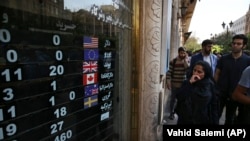One of the hypotheses about the reasons behind the unusual rise in the rate of exchange for the US dollar and other hard currencies in Iran is that the government itself has devalued its own currency rial, as a way of funding its day to day expenses such as paying public sector salaries.
This has been an accusation that has been levelled against successive administrations in Iran for four decades. Every Iranian President has experienced a forex market shock during his tenure and has been accused of manipulating the forex market.
Iranian governments including the Rouhani administration have always denied the accusation; usually levelled by MPs, political rivals as well as foreign and Iranian economists.
Nevertheless, the accusations are repeated thanks to lack of public confidence in Iranian governments. When governments have a legitimacy problem, the accusation of manipulating the forex market becomes more serious.
But apart from conspiracy theories and lack of confidence on the part of the people, there are also economic realities to lend some credibility to the hypothesis.
Economic reasons
The main part of the Iranian government's hard currency income comes from oil exports.
In order to spend the dollars on the Iranian market, the government has to convert it into Iranian rial. Two key figures in the Iranian annual budget are arbitrary - the rate of exchange forecast for the year and an estimated value of every barrel of oil to be sold on the international market.
In this year's budget, the forecast for the price of oil is 55 US dollar and the rate of exchange for every dollar is 35,000 rials. Neither of these figures has materialized, as the rial has lost a lot of value and the price of oil has gone up.
The rise of the dollar in Iran and the relentless demand for it, has offered a unique opportunity for the central bank and the government to make money; whether as part of an intentional plan of manipulation or in a natural manner.
Selling dollars from the oil income at a triple rate on the open market, gives the government so much more rials to take care of its domestic operating expenses.
According to an Iranian Central Bank report, the unexpected rise in the government's oil income during the past five months has been 540 trillion rials, at least 18 percent more than what it expected.
At the same time the government earned 660 trillion rials less non-oil income such as taxes than it had anticipated.
The gap, the result of economic slowdown, shows that the government needs more cash to spend on its operating expenses, so it needs to use its petrodollars. Luckily for the state, these dollars are being sold to the people at a much higher rate than last year.
Is there a conspiracy?
In an ideal and logical world, it is unlikely that a government would intentionally bring down the value of its national currency, just to sell its dollars at a higher rate. This can have serious consequences for the country’s economy.
It is unlikely that a security-conscious government such as Iran’s would take such a risky step that can go out of control and lead to unrest. However, institutionalist economists such as Hossein Raghfar insist that this is what Tehran's government has done.
According to Raghfar, the government has been manipulating the rate of exchange in order to solve the problems of Iranian banks, particularly the private ones and to serve the interests of a certain group.
Iran’s banking system is reliant on the state and not managed according to free market rules or regulations. Many have been in serious trouble and have to be propped up by the state.
This comes while the Iranian government has refused to introduce essential structural reforms in the economy fearing their political and security consequences.
Although there are the U.S. sanctions and other reasons why the Iranian currenct has lost value, but it is not beyond the realm of possibility that the Iranian government may have taken a risk to manipulate the forex market, in the same way it has taken too many other outlandish measures in various areas during the past 40 years.







